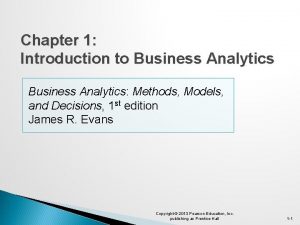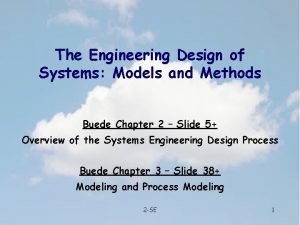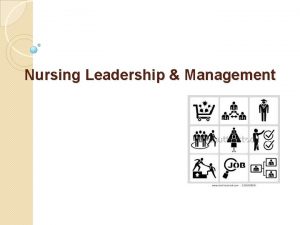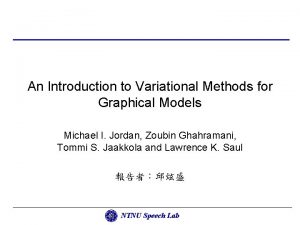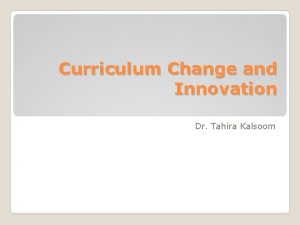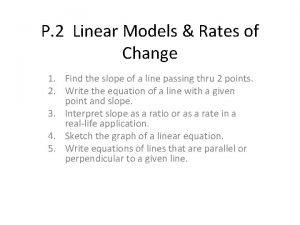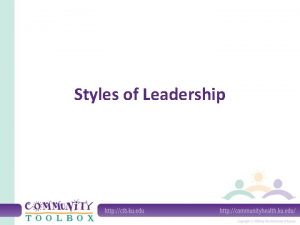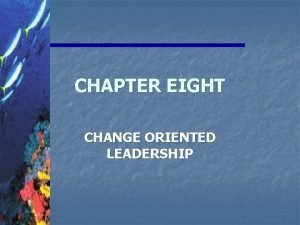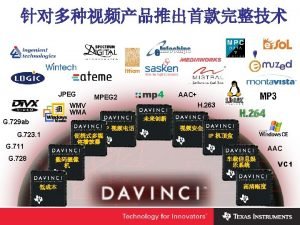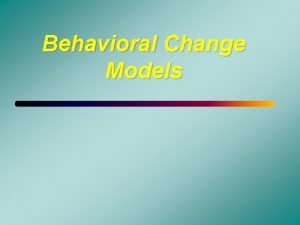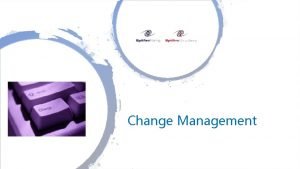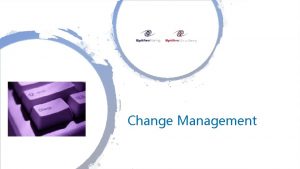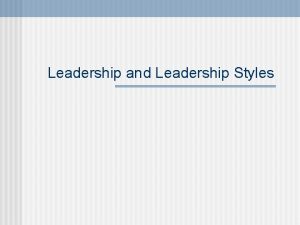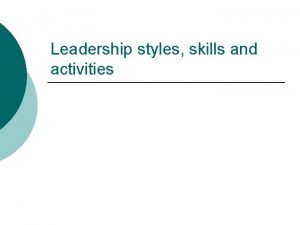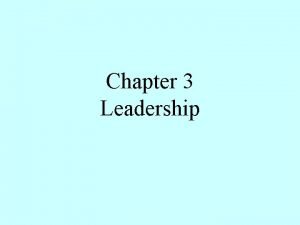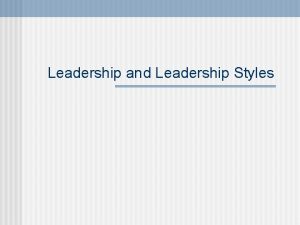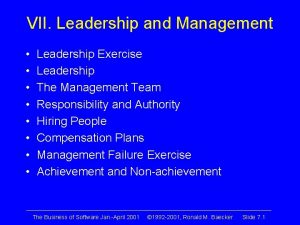OC 6443 Change Leadership methods and Models Week
























- Slides: 24

OC 6443 Change Leadership methods and Models Week 4 Change: The 8 -Step process

Organizational Change Practices • Which Practices Do We Employ? – Collective or collaborative approaches – Strategic Planning and goal setting – Stages of praxis – Ethical practices • How do they link to concepts of organizational change and leadership?

Collective or Collaborative Approaches • Institutional leadership and change practices – Coherence and – Agility – 12 leadership systems (see page 81, text 1) • Keys to collective development – Professional development – Performance appraisal – Compensation systems

Collective or Collaborative Approaches cont’d • Organizational learning – Adapt to changes in the environment – Encourage experimentation and innovation – Continuous renewal of structures and processes • Keys to organizational learning (Senge): – Personal mastery – Mental models – Shared vision – Systems thinking

Collective or Collaborative Approaches cont’d • Shared power or empowerment – Leaders willing to share power • Delegate or distribute leadership – Best practices: • • • Decide if needs or wants empowerment Create clear vision, goals, accountabilities Develop others Delegate decision making to followers Lead by example Make empowerment systemic through selection, appraisal, rewards, training, organizational structure

Strategic Planning • Traditional planning process – SWOT – Industry analysis – Updated vision, purpose, mission – Key areas: • • Stakeholder analysis Competitive advantages Demographic changes Social and lifestyle changes Technology changes Economic changes Legislative/regulatory changes Global changes

Stages of Praxis • Kurt Lewin’s force field model – When we recognize the old way is no longer effective due to crises, threats, new opportunities • Stages of change: – Unfreezing • Resistance to change: – – – – Lack of trust Belief its unnecessary economic Cost Fear of failure loss of power Threat to values Resentment of interference Psychological Safety?

Stages of Praxis cont’d – Changing phase: • Create an image of a realistic, credible, and appealing future of the organization that – – Energizes people Inspires commitment Gives meaning to work Establishes a standard of excellence • The guiding coalition develops the strategy to achieve the change • How: – Dialogue, discourse, conversation – Creates a meaningful exchange, generates understanding – The spirit of inquiry is essential to dialogue – focuses on connections, embraces diverse perspectives, allows for shared understanding

Stages of Praxis cont’d – Refreezing or Anchoring New Approaches in the culture • How to influence culture, primary means: – – – Attention Reaction to crises Role modeling Allocation of rewards Criteria for selection of dismissal • Secondary means: – – – Design of systems/procedures Structure Rites and rituals Facilities Stories, legends, myths Formal statements

Stages of Praxis cont’d • Scenario building – Uses facts, indicators and trends to project alternative futures – Provides a useful means for developing informed action • Appreciative Inquiry (AI) – Choose the positive for the inquiry – Inquire into life-giving forces – Locate themes that appear in the stories, develop for further inquiry

Stages of Praxis cont’d • E-Practices – How to aid in virtual environments • • Training Team building Task and relational roles Standards of communication Process structuring Frequent communication and feedback Continuous emphasis on relational development Anticipate unintended consequences

Stages of Praxis cont’d • Ethical Practices – Attend to the leaders and followers take into account their actions in relationship to others – Ethical decisions and practices – What should be done in regards to coworkers and customers – Moral compass – Authenticity, trust, reciprocal care – Beware ‘bogus’ empowerment – Openness and transparency


Driving New Initiatives and Change in the Organization Eight Steps to Driving Change *: 1. 2. 3. 4. 5. 6. 7. 8. Establish a Sense of Urgency Building the Case ~ Resistance to change Build a Coalition Identify stakeholders and build alliances Create a Shared Vision Communicate Vision Repeatedly Empowering Others to Act on the Vision Planning for and Creating Short Term Wins Reinforce the Change Institutionalizing New Approaches Leading Change, John P. Kotter, HBS Press, 1996 The Heart of Change Field Guide, Dan S. Cohen, John P. Kotter, HBS press, 2005

Leading Change Model 1. Establish a Sense of Urgency • Examining market or demographic realities • Identifying and discussing crises, potential crises or major opportunities • Why might people fail here: – Underestimating how hard it can be to drive people out of their comfort zones – sometimes grossly overestimate how successful they have already been in increasing urgency – sometimes lack the patience 2. Forming a Powerful Guiding Coalition • Assembling a group with enough power to lead the effort • Can be as small as 3 -5 individuals, work as a team

Leading Change Model 3. Creating a Shared Vision • Picture of the future, easy to communicate, and appeals to staff, leaderships and stakeholders • Developing strategies for achieving that vision 4. Communicate Vision Repeatedly • Leading change is usually impossible unless large numbers of people are willing to help • How? Organizational newsletters, Quarterly management meetings… • Use every possible channel, especially those that are being wasted on non-essential information

Leading Change Model 5. Enable Your Team to Achieve the Vision • Getting rid of obstacles • Changing systems or structures that undermine vision 6. Planning for and Creating Short Term Wins • Planning for visible performance improvements • Creating the improvements • Recognizing and rewarding employees involved in the improvement

Leading Change Model 7. Reinforce the Change…Producing still more change • Using increased credibility to change systems, structures and policies that don’t fit • Hiring, promoting, and developing employees who can implement the vision • Reinvigorate process with new projects and themes 8. Institutionalizing New Approaches “…the way we do things around here. ” • Articulating the connections between the new behaviors and organizational progress/success • Developing the means to ensure leadership development and succession

Weave into the Fabric of the Organization • eliminate the perception of “add on” • establish the business case • link to quality of care • legitimize in policy, structures, practices, procedures, & resources • set bench marks & measure progress at regular intervals • assure it is woven into the “culture” of the organization Slide Source: The National Center for Cultural Competence, 2004

PAU!




 Week by week plans for documenting children's development
Week by week plans for documenting children's development Modals and semi modals difference
Modals and semi modals difference Business analytics methods models and decisions
Business analytics methods models and decisions Business analytics methods models and decisions
Business analytics methods models and decisions Scope of business analytics
Scope of business analytics Linear programming models graphical and computer methods
Linear programming models graphical and computer methods The engineering design of systems: models and methods
The engineering design of systems: models and methods Likert leadership theory
Likert leadership theory Transactional vs transformational leadership
Transactional vs transformational leadership An introduction to variational methods for graphical models
An introduction to variational methods for graphical models Strategies for curriculum change and innovation
Strategies for curriculum change and innovation Linear models and rates of change
Linear models and rates of change Metal coping fpd
Metal coping fpd Leadership methods
Leadership methods Adaptive leadership theory
Adaptive leadership theory Adaptive leadership vs situational leadership
Adaptive leadership vs situational leadership Chemical change
Chemical change Absolute change and relative change formula
Absolute change and relative change formula Difference between physical and chemical change
Difference between physical and chemical change Supply and demand curve shifts
Supply and demand curve shifts Physical change and chemical change
Physical change and chemical change Rocks change due to temperature and pressure change
Rocks change due to temperature and pressure change Whats a chemical change
Whats a chemical change Second order change
Second order change Change oriented leadership
Change oriented leadership




